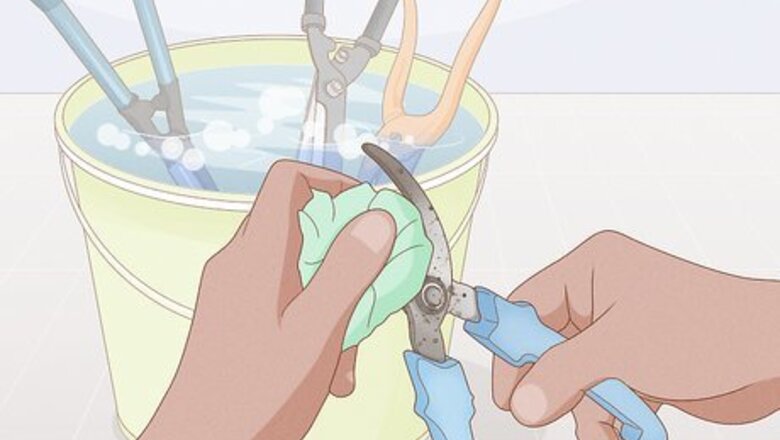
views
- Cut away smaller branches using double-bladed gardening sheers or a handsaw. For larger branches, use a chainsaw.
- Trim the branches into a “martini glass” V-shape. Remove weak, dead, and vertically-growing branches, leaving gaps so sunlight reaches the middle of the tree.
- Prune your tree once a year at the end of winter, before buds appear. Remove weak, dead, and vertical branches, plus any extras sprouting from the trunk.
Cutting the Branches
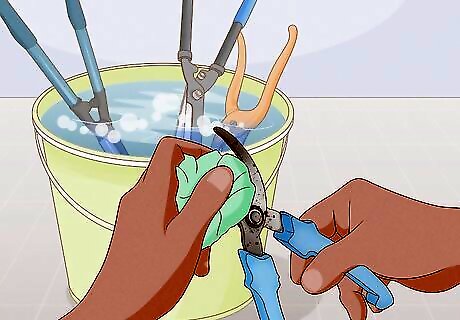
Buy or rent double-bladed sheers, a handsaw, and a chainsaw. You can purchase double-bladed sheers and a handsaw online. Or try your local hardware store, where you can also rent a chainsaw for the day. Make sure your sheers and handsaw are sharp and clean before using them. If your sheers and saw are dull from use, take them to a hardware store to have them sharpened for a small fee. To clean your shears or saw, dip the blades in isopropyl alcohol for 30 seconds to disinfect them, then carefully wipe them dry with a clean towel. You can buy double-bladed gardening sheers online for around $15, while a 14-inch (35 cm) handsaw costs less than $20. You can rent a 16-inch gas-powered chainsaw for just $58 per day, before taxes. You’ll need to buy the gas separately.
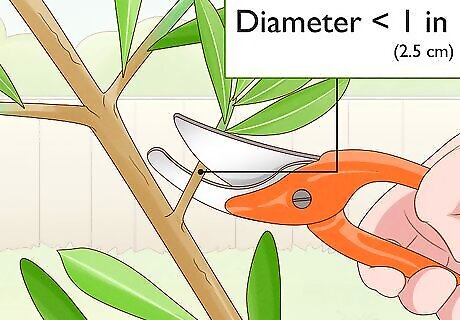
Use shears to cut shoots less than ¾ in. (2 cm) in diameter. Cut the shoot as close to the branch as possible. For shoots longer than 12 inches (30 cm), cut 1-2 inches (2-5 cm) from the branch and pull the shoot away. Then trim the remaining length of the shoot, leaving a small nub where the shoot was attached. Cut cleanly through the shoot before pulling it away. If you pull on it while it’s still attached to the branch, you could damage the rest of the tree.
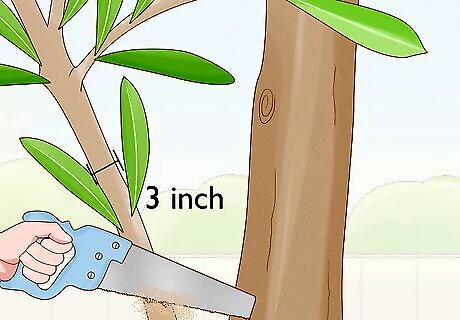
Use a handsaw for branches 1-3 in. (2.5-7.5 cm) in diameter. Make your first cut upward from the bottom of the branch (the side facing the ground) roughly 18 inches (45 cm) from the tree’s trunk. Cut about halfway through. Then make a second cut halfway through the branch, cutting downward from the top roughly 1 inch (1.5 cm) farther from the trunk than the first cut. The branch should break under its own weight. Pull the branch away, then cut the remaining piece of branch, leaving a short nub on the tree’s trunk. If the branch doesn’t break under its own weight, pull it downward until it snaps. Use the saw to cut it away completely.
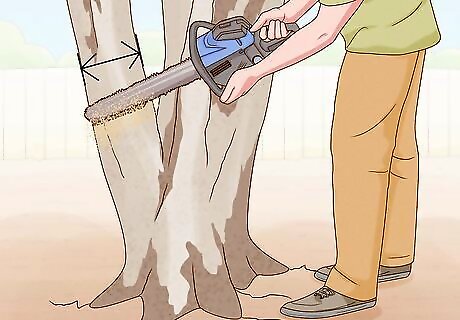
Use a chainsaw for branches thicker than 3 in. (7.5 cm). Wearing safety goggles, a worker’s helmet, and cut-resistant chainsaw gloves, make your first cut on the bottom side of the branch (the side facing the ground), roughly 18 inches (45 cm) from the trunk. Cut upward until you’re halfway through. Then make another cut on the top of the branch, 1 inch (2.5 cm) farther from the trunk. Cut downward until you are halfway through, or until the branch snaps under its own weight. Pull the branch away and cut the remaining bit of branch, leaving a clean cut that’s flush against the trunk. This is called a “heading” cut. Make your final heading cut slant downward so that water can slide off easily. For safety, always stand to the side of a branch when cutting it. Large branches are extremely heavy and can cause injury. Use a ladder for branches you cannot reach. Avoid standing or placing a ladder directly under the branch you’re cutting.
Shaping Your Tree
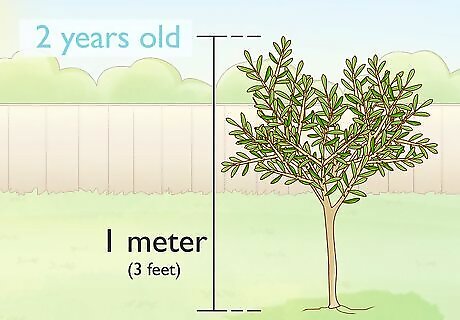
Let your tree grow naturally for the first 2 years. Your tree should be roughly 1 meter (3.3 feet) tall and have 3-4 strong lateral branches. It’s best not to prune trees younger than 2 years old, since this can stunt their growth. Your tree won’t bear fruit until it’s 3-4 years old. Avoid removing more than 3-4 shoots and branches from trees younger than 4 years old. Over-pruning can permanently damage young trees.

Prune once a year at the end of winter, before flower buds appear. This will stimulate your tree’s metabolism and promote growth, without risking damage from frost and ice. If you live in a warmer climate where the temperature never goes below freezing, you can prune during the winter. If necessary, you can prune after flowers start to appear, but this will limit the number of flowers and olives available for harvest. Avoid pruning after flowers have fully bloomed, since this can cause your tree to lose nutrients.

Prune your tree so that it looks like a vase or martini glass. Find 3-4 strong lateral branches that are at least ¾ inches (2 cm) thick and growing out and upward from the trunk. Leaving these branches in place, prune other branches so that the tree is wider at the top and narrow at the base of the leaves, like the shape of a martini glass. The trunk itself should look like the stem of the glass. Cut small, weak, or vertical branches aside from these main 3 or 4. If your tree only has 2 strong lateral branches, you can still prune your tree. But be sure to look for 3-4 strong branches when you prune again the following year.

You can also try other shapes, like a globe, vasebush, or bush. Each shape has advantages and disadvantages. Some require more pruning, a few are meant for large orchards with many trees, and some are suited for “mechanical” harvesting where olives are picked with machines. The globe shape is round, like a globe or ball. This shape is great for places with intense sunlight, but pruning can be more difficult. The vasebush shape resembles the martini glass, but with no trunk forming the “stem” of the glass. Branches grow from every part of the trunk, allowing olives to be picked by hand from the lower branches. When a bus shape is used, the tree is left to grow naturally, with minimal pruning. This makes it extremely low-maintenance, but the olive yield may be lower. The “central leader” approach makes your tree look cone-shaped, like a Christmas tree. This is great for mechanical harvesting, but pruning and maintaining this shape is challenging. “Single trunk free canopy” is a low-cost, low-maintenance approach to olive trees used in orchards and mechanical harvesting. Little or no pruning is done, and each tree in the orchard looks different.
Annual Pruning
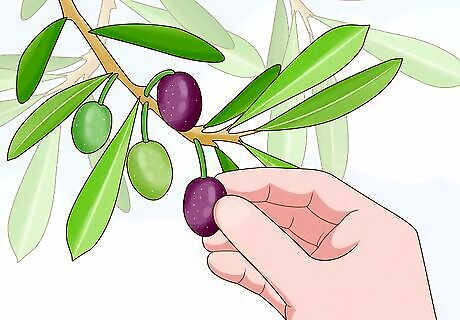
At harvest time, note which branches have the most fruit. These are branches you should keep when you prune your tree next year. They should appear heavy and weighed down by the fruit. Weaker branches, or branches that are growing vertically, should be pruned once winter has ended. Harvest time usually takes place in the fall. However, the specific date can vary depending on climate, temperature, sunlight, and other factors. You can harvest your olives when they are fully ripe. The signs of ripeness depend on the type of olive, but many varieties are only considered ripe when they turn fully black.
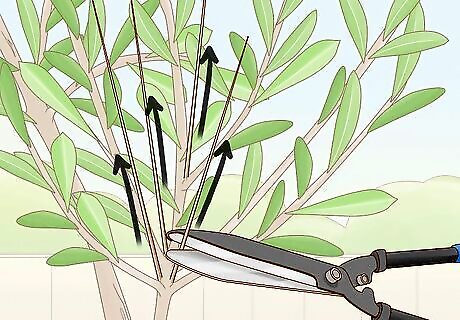
Begin pruning by removing vertical branches. Fruit only grows on lateral branches, so be sure to remove any branches that are growing straight up. Remove smaller branches and shoots so that tree is less branch-dense. This is called “thinning,” and it helps sunlight reach the center of the tree. A rule of thumb is that a bird should be able to fly through your olive tree without hitting leaves. If your tree is too dense with vertical branches in the middle, a bird would not be able to do that, and you should remove more vertical branches.

Cut lateral branches that look weak or dead. As your tree ages, some of its branches may become old and no longer bear fruit. These branches take energy away from a tree, which can limit the amount of fruit it produces. Dead branches can also develop disease and are prone to snapping in the wind. Weak branches often have cracked or pealing bark, and may still have leaves. Dead branches may lose their bark and start to rot. They may also break off more easily, so be cautious when handling them.
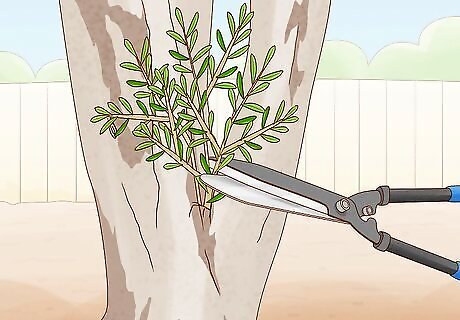
For year-round pruning, remove any branches sprouting from the trunk. These can be near the bottom of the trunk, or anywhere below the main “fork” of the tree (where most of the branches are clusters). These branches are usually small, grow vertically or downward, or otherwise don’t fit with the tree’s “martini glass” shape. You can remove these extra branches any time of the year.















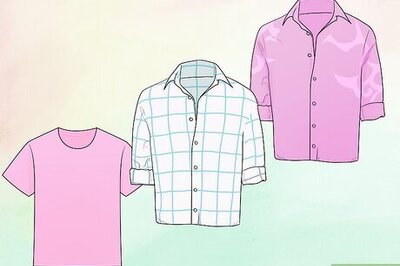
Comments
0 comment